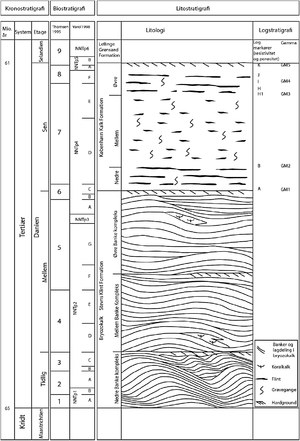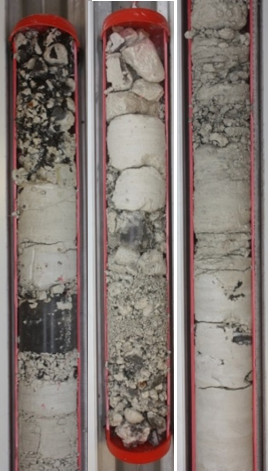Geology and properties of limestone
| Highlights |
|---|
|

Geology and hydrogeologyIn eastern Denmark, glacial Quaternary deposits (clayey till, sand) are usually on top of limestone aquifers. The uppermost limestone layer is typically a calcarenitic limestone (also called Københavns Kalk), followed by bryozoan limestone. The calcarenitic limestone is rather evenly and horizontally layered and may contain flint layers and nodules. The bryozoan limestone typically shows bank structures and few to no flint inclusions. A good description of the geologic stratification in the greater Copenhagen area is given in the Report by GEO and GEUS [1]. Figure 1 shows the typical krono-, bio- and lithostratigraphy in eastern Zealand (Denmark) and in the Øresundsregion. Limestone geologies are often heavily fractured and especially the calcarenitic limestone includes almost impermeable chert layers and nodules. The chert layers can stretch over distances of tens to hundreds of meters or they can occur as loose inclusions embedded in the limestone. Figure 2 shows some borehole cores from the Akacievej site, which illustrate the heterogeneity of the limestone with chert, crushed material and fractures. The upper part of the limestone aquifer may be crushed due to glacial activity. At the Akacievej site, a crushed layer with a thickness of 3-5 m was observed. It has different hydraulic properties than the fractured limestone, f.e. the bulk hydraulic conductivity was lower than in the fractured limestone below. Limestone aquifers are often very heterogeneous and the hydraulic parameters can span over wide ranges and have a strong spatial variation. As with many other geologic materials, limestone aquifers are typically anisotropic, which means that their horizontal hydraulic conductivity is about 2 to 10 times as high as in the vertical direction. Major horizontal fractures can intensify the observed degree of anisotropy. The intact limestone matrix has a very low hydraulic conductivity. When fractures are present, their conductivity is often orders of magnitude higher than the matrix and flow occurs predominantly in the fractures. Different kinds of fractures can be distinguished: horizontal fractures, which are often caused by decompression (related to glacial activity), and vertical/subvertical fractures, typically caused by tectonic activities. Fractures can influence the anisotropic behavior of limestone aquifers, because the groundwater flow is guided through the fractures. Due to that, it is possible that the main flow direction differs from the overall hydraulic head gradient, and the direction of the major fractures has to be considered. The orientation of the vertical fractures is, as a rule of thumb, often aligned with major faults in the area [1]. Limestone has a relatively high matrix porosity (between 7 and 46 Vol.-% were observed at the Akacievej site [2]). The porosity of the fracture system (volume fraction of the fractures), where groundwater flow and advective transport often mainly take place, is comparably low (0.5 to 2 Vol.-%). Properties of the limestone at Akacievej (Hedehusene, Denmark)The local geology at the Akacievej site in Hedehusene (eastern Denmark) is described here. Based on a set of different measurements and modeling interpretations, hydraulic parameters and transport parameters were determined for the Akacievej site. The employed field methods are described in the Chapters Data acquisition and field methods and Determination of transport parameters and contaminant data. Table 1 gives an overview of values that were determined at the Akacievej site.
The sorption behavior for chlorinated solvents on limestone was examined in Salzer (2013) [3]. For chlorinated solvents like PCE, sorption to limestone can be strong ($k_d$ values of $0.5-1 \ \text{L/kg}$ were measured in lab tests). |
- ↑ 1.0 1.1 1.2 Galsgaard et al. (2014), Strømning og stoftransport i kalklagene på den københavnske vestegn (in Danish).
- ↑ Broholm et al. (2016a), Sammenligning af niveauspecifikke prøvetagningsmetoder for vurdering af koncentrationsfordeling i kalkmagasin (in Danish). Technical University of Denmark, DTU Environment
- ↑ 3.0 3.1 Salzer, J.P. (2013), Sorption capacity and governing parameters for transport of chlorinated solvents in chalk aquifers, Master Thesis, DTU.
